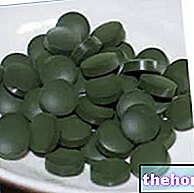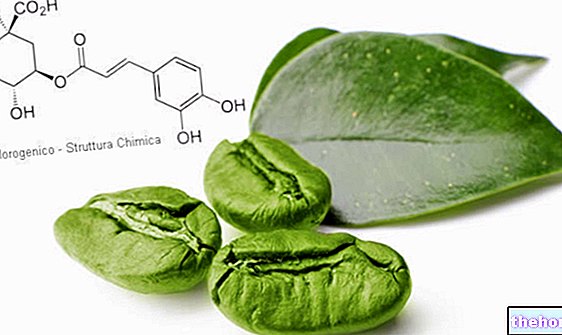Generality
Chlorogenic acid (CGA) is a phenolic compound.
It therefore belongs to the category of polyphenols, powerful antioxidants widely present in plants, many of which find space in human nutrition.

Chlorogenic Acid in Food
Chlorogenic Acid in Coffee
Chlorogenic acid is found in high concentrations in green coffee, while its bioavailability is reduced due to roasting (a compound originating from coffee roasting, called HHQ, appears to inhibit the action of chlorogenic acid in vivo).
A liter of coffee provides 500 to 800mg of chlorogenic acid (250-400mg of caffeic acid).
Although green coffee is the subject of most of the research related to the health applications of the CGA, mate is also a particularly generous source of chlorogenic acid. This well-known South American drink seems to contain around 2.1mg per gram (over two grams per liter).
Chlorogenic acid in other foods
In addition to coffee, natural sources of chlorogenic acid are represented by several commonly used plant foods, such as apples, blueberries, peaches, pears, plums, tomatoes, aubergines, peanuts and potatoes.
Chlorogenic acid is one of the most abundant polyphenolic compounds in the human diet, which in the case of generous consumption of coffee and plant foods can provide up to one gram per day.
Chemical Characteristics
Despite its name, chlorogenic acid does not have chlorine atoms in its chemical structure. It owes its name to the Greek term χλωρός ("green"), attributed according to the green color of its oxidation products.
As anticipated, chlorogenic acid belongs to the polyphenol family, which in the complex has over 8,000 compounds.

Depending on the number of phenolic rings they contain and the structural elements that bind these rings to each other, phenolic compounds could be divided into 10 general classes; among these, the most abundant in the plant kingdom are phenolic acids, lignans, stilbenes and flavonoids.
In turn, phenolic acids include two classes: those deriving from benzoic acid and those deriving from cinnamic acid. Chlorogenic acid falls into the latter category.
In particular, it derives from the esterification of caffeic acid with quinic acid and has different isomers, among which the most common form is 5-caffeolquinic acid (5-CQA).
Pharmacology and metabolism
The absorption capacity of chlorogenic acid by the human intestine seems limited. In studies on rats very modest percentages, up to 8% by weight, of the ingested CGA are hydrolyzed into caffeic acid and consequently absorbed. In some studies conducted on ileostomised subjects, absorption percentages equal to 30% for chlorogenic acid were recorded and 95% for caffeic acid.
The action of the colon microbiota on the unabsorbed chlorogenic acid appears to be rather important, as it participates in its digestion by releasing caffeic acid and other metabolites available for absorption by the colonic mucosa.
The numerous metabolites of caffeic acid, produced and absorbed in the intestine, or at other levels, appear to be responsible for the biological effects of this substance; among the most important metabolites are mentioned caffeic and dihydrocaffeic acid, hippuric acid, ferulic acid, vanillic acid and benzoic acid.
Indications
Why is Chlorogenic Acid used? What is it used for?
In addition to the generic antioxidant effect, chlorogenic acid may have a modest hypotensive effect; it has also shown positive effects in slowing the release of glucose into the blood after a meal, reducing the absorption of sugar in the intestine.
Taken together, these effects could assist in the loss of body weight induced by appropriate nutritional and behavioral interventions (increased physical activity).
The integration with chlorogenic acid could therefore be particularly valuable for subjects suffering from metabolic syndrome.
Properties and Effectiveness
What benefits has chlorogenic acid shown during the studies?
The most studied health applications of chlorogenic acid concern its hypotensive and blood glucose modulating effects.
Chlorogenic acid also exhibits interesting antioxidant, antibacterial and anti-inflammatory properties.
Some experimentalists also attribute to chlorogenic acid a possible positive effect in supporting the mood.
Chlorogenic Acid and Hypertension
The integration with chlorogenic acid would seem to guarantee a reduction of about 4.5 mmHg for the maximum pressure (systolic) and of 3.5mmg Hg for the minimum pressure. The study with the most encouraging results indicates reductions in the order of 15mmHg for the systolic and 5mmHg for diastolic after 12 weeks of treatment with 280mg of chlorogenic acid per day divided into two intakes.
Clinical studies supporting these effects are scarce, limited to the Asian population and funded by chlorogenic acid manufacturers. More extensive and independent trials would therefore be desirable
Chlorogenic acid as a hypoglycemic agent
Equally timid is the scientific evidence relating to the ability of chlorogenic acid to improve glucose tolerance, reducing post-prandial glycaemia.
Chlorogenic acid would seem to modify glucose metabolism especially in the intestine, reducing post-prandial glycemic peaks and opposing the weight gain induced by a diet rich in sugars.
These evidences have been collected mostly on animal models, while sufficient confirmations are lacking in clinical studies (in the most encouraging one, 1g of chlorogenic acid administered to obese subjects reduced the glycemic values recorded after an oral load of OGTT glucose by an average of 15mg, also reducing insulin levels of −73 pmol / l).
Chlorogenic acid for weight loss
In a clinical study, the consumption of coffee enriched in chlorogenic acid induced a reduction in glucose absorption of 6.9%; in addition, regular consumption for 12 weeks induced a reduction in average body weight of 5.4 kg in overweight people. Again, further investigation is needed, since other studies have not recorded positive effects on weight reduction.
Chlorogenic acid as an antioxidant
Chlorogenic acid has shown remarkable antioxidant properties, both in vitro and in vivo. As evaluated by the ORAC tests, chlorogenic acid appears to have an antioxidant power comparable to that of caffeic acid, but lower than that of dihydrocaffeic acid.
Other properties "
The use of chlorogenic acid as a food additive has been proposed to slow down fruit wilting after harvesting.
Dosage and method of use
How to use Chlorogenic Acid
It has been estimated that those who regularly consume coffee and other CGA-rich foods consume 0.5g to 1g of chlorogenic acid per day; however, roasting coffee could generate compounds that reduce the bioavailability of the chlorogenic acid present in the food. Those who do not regularly drink coffee and consume a diet low in fruit and vegetables could also take in less than 25mg of CGA per day.
The intake ranges most used in the studies cited so far are in the order of 120-300mg of chlorogenic acid per day, distributed in a single or two daily intakes.
These are doses that can be reached simply by following a "diet that includes moderate to high doses of foods rich in chlorogenic acid, in particular green coffee extracts, without the need for specific supplements.
Side effects
The use of Chlorogenic Acid is generally safe and well tolerated.
Only a small percentage of the chlorogenic acid taken from the diet is absorbed; this particularity has been related to the laxative effect produced by the excessive consumption of fruits - such as plums - which are rich in them.
Chlorogenic acid (like coffee) appears to increase homocysteine levels in the blood, which is a known cardiovascular risk factor; however - given the positive effects on blood pressure and glucose absorption - this increase is unlikely to occur. materialize in an effective increase in cardiovascular risk.
Contraindications
When Chlorogenic Acid should not be used
The use of chlorogenic acid is contraindicated in case of hypersensitivity to the active ingredient; in literature there are reports of allergic reactions to green coffee and its extracts, but they do not seem to be attributable to chlorogenic acid.
Pharmacological interactions
What drugs or foods can modify the effect of Chlorogenic Acid?
Chlorogenic acid could enhance the effect of oral hypoglycemic agents taken at the same time.
Chlorogenic acid could reduce the absorption of zinc and non-heme iron taken together.




























